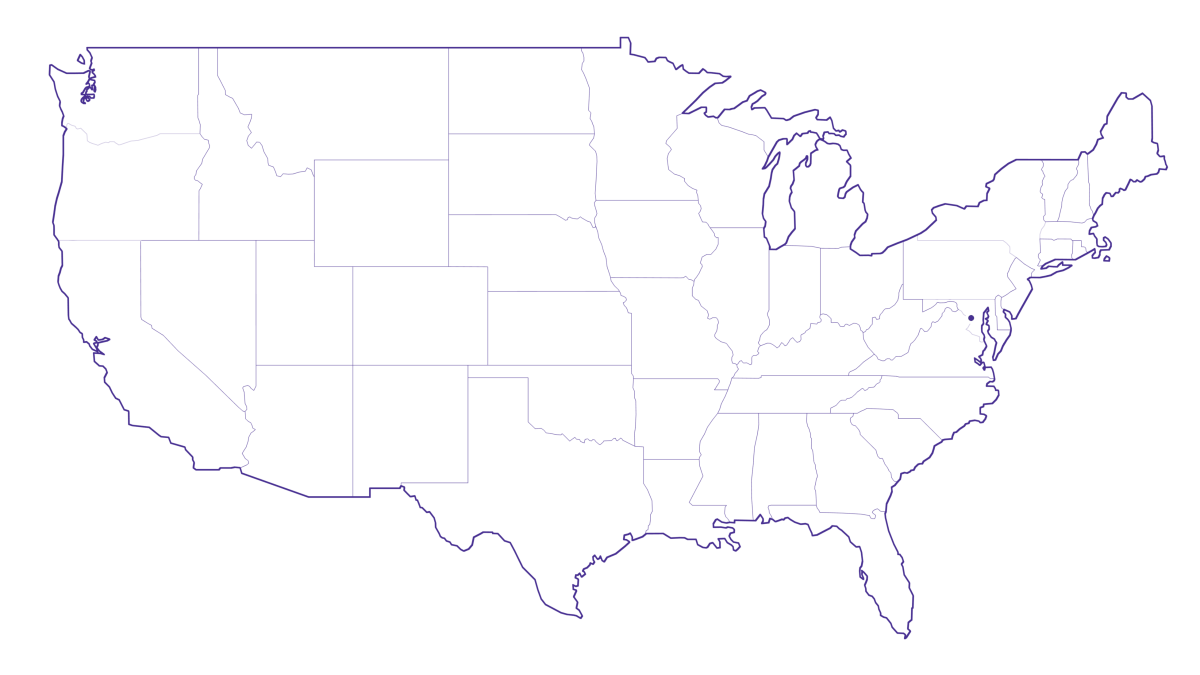What is the average cell phone bill per month in 2025?

Are you trying to figure out what your average monthly cell phone bill should be in 2025? Cell phone bills have been steadily rising recently, with single plans averaging $70 to $100 and family plans costing between $160 and $200 monthly.
Cell phone plans usually include monthly bills that charge for the data plan, talk and text services, device payments and surcharges. However, many consumers are surprised by the increasing costs, hidden fees and confusing plan structures. Without clear information, it’s easy to overspend without understanding your average monthly cell phone bill or knowing how to cut back costs.
Fortunately, we’ve analyzed the latest 2025 industry data. In this article, you’ll learn about the average monthly cell phone bill in 2025, why it fluctuates and how single and family plans compare. You’ll also find practical tips on how to save, like bundling services with providers like Astound Mobile.
What you'll learn:
- What is the average cell phone bill in 2025?
- Average monthly cell phone bill costs in 2025
- The rising costs of cell phone plans
- Why are cell phone costs rising?
- Single line vs. family cell phone plan comparison chart
- Why do cell phone bills fluctuate?
- Understanding the monthly billing cycle
- 6 reasons why your cell phone bill is high
- 5 tips to lower your cell phone bill
- Save more when you bundle home internet and mobile with Astound
- Conclusion
- Frequently asked questions
- Related articles
COMPARE INTERNET SOLUTIONS
Save when you switch to Astound
Looking for smarter ways to put money back into your pocket? Bundle internet, mobile and TV with Astound and watch your savings grow.
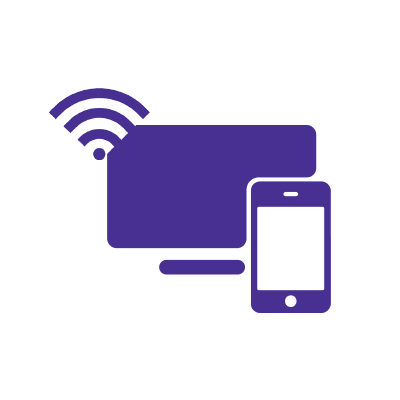
What is the average cell phone bill in 2025?
Based on recent market trends and industry data, the average monthly cell phone bill in 2025 is estimated to range between $150 and $160. Single-line plans range between $70 and $100, and family plans cost between $160 and $200. These ranges depend on your plan type, number of lines and included features, making the annual costs average between $840 and $2400.
These costs are notable increases from the 2023 average of $141 per month, as reported by JD Power. That’s a 3.8% annual increase, driven by inflation, increasing mobile data consumption and the nationwide rollout of 5G coverage.
However, cell phone bills vary widely depending on your mobile carrier, chosen plan type (single-line or family plan) and data usage (by-the-gig or unlimited data).
Below is a table breaking down typical monthly and annual costs based on different plan types.
Average monthly cell bill costs in 2025
| Plan Type | Estimated Monthly Cost (2025) | Estimated Annual Cost |
|---|---|---|
| Single Line | $70 - $100 | $840 - $1,200 |
| 2-Line Plan | $120 - $140 | $1,440 - $1,680 |
| 4-Line Plan | $160 - $200 | $1,920 - $2,400 |
|
Plan Type
Single Line |
Estimated Monthly Cost (2025)
$70 - $100 |
Estimated Annual Cost
$840 - $1,200 |
|
Plan Type
2-Line Plan |
Estimated Monthly Cost (2025)
$120 - $140 |
Estimated Annual Cost
$1,440 - $1,680 |
|
Plan Type
4-Line Plan |
Estimated Monthly Cost (2025)
$160 - $200 |
Estimated Annual Cost
$1,920 - $2,400 |
The rising costs of cell phone plans
Over the past five years, the average cell phone bill has risen from approximately $130 in 2021 to $155 in 2025. That’s a 19% increase, outpacing general inflation and further straining household expenses.
The line graph below charts the average monthly cell phone bill trend from 2021 to 2025. It shows a steady increase due to inflation, 5G adoption and data usage.
Average monthly cell phone bill
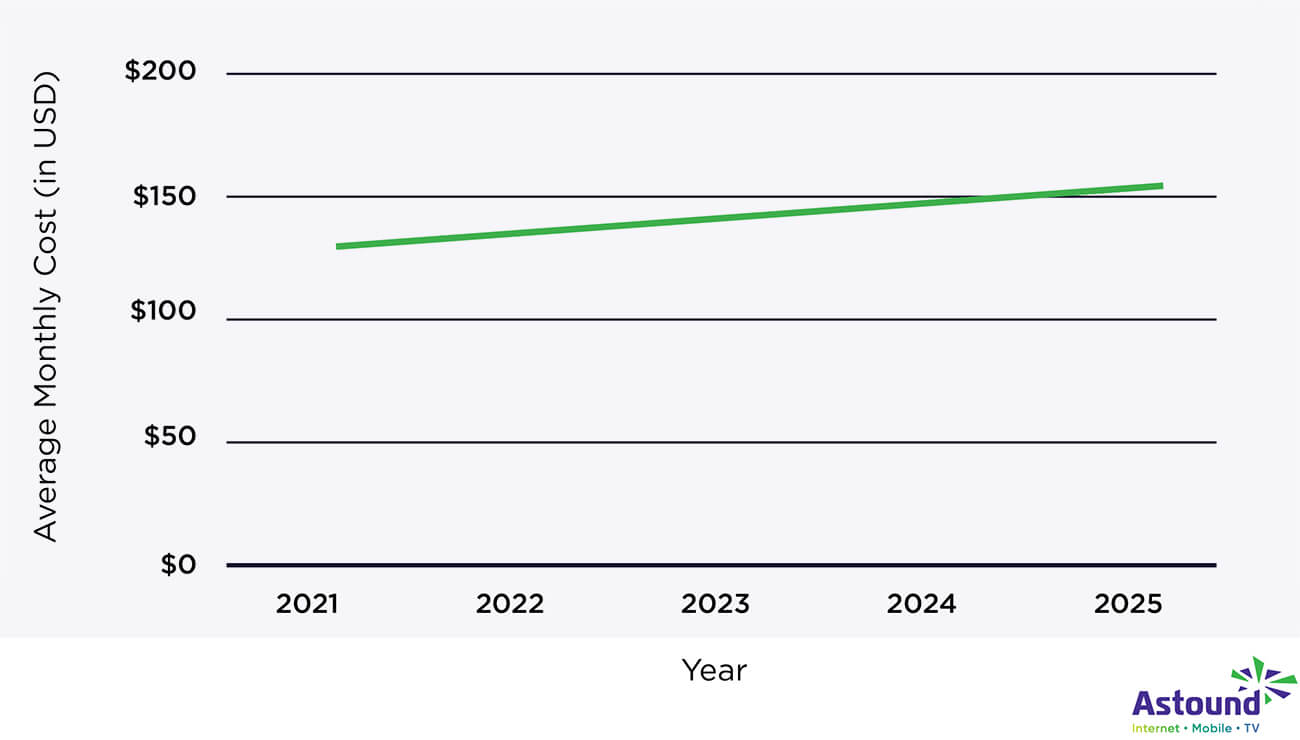
Note: Data for 2021-2023 are based on historical reports; 2024-2025 are estimates reflecting ongoing inflation and 5G trends.
Why are cell phone costs rising?
The main data points behind this trend include:
- 5G adoption: Carriers are investing heavily in deploying 5G network infrastructure nationwide. While 5G introduces faster internet speeds and reliable connections, these improvements come at a cost. Some carriers transfer these costs to consumers by imposing premium plans or surcharges ranging from $5 to $10 monthly for 5G access.
- Inflation and carrier rate increases: Inflation has impacted telecom services. Carriers have raised their prices for cell phone plans to offset their higher operational costs.
- Increased data consumption: With streaming, mobile gaming and remote work becoming the norm, the average user now consumes up to 21 GB per month, according to Ericsson. While some users may benefit from by-the-gig plans, others opt for unlimited data, which typically costs more.
- Device financing: The price of new flagship 5G-capable phones is increasing, ranging from $500 to $1,000. Instead of paying upfront, many consumers choose monthly installment plans, which add $20 to $40 to their phone bill each month over a two- to three-year contract.
Understanding the factors for the rising costs is the first step in avoiding overpaying for phone bills in 2025. You can stay connected without overspending by comparing carrier prices, customizing plans with mix and match options and exploring bundling options.
See how much you can save
Save with Astound
Check out our savings calculator to see the change in your bill when you build a plan with Astound.
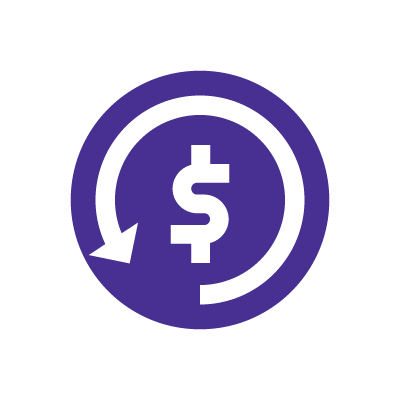
Single line vs. family cell phone plans
Selecting a phone plan should align with your current needs and budget. While a single-line plan makes sense for some, it’s not cost-effective if you manage multiple lines for your family members.
For example, a single-line user who frequently streams content, plays mobile games or uses a mobile hotspot may need an unlimited plan, which averages between $70 and $100 monthly.
Comparatively, light users who engage in basic online activities, such as checking emails, social media or web browsing, could benefit from by-the-gig options, which cost as little as $25 to $40 per month.
Choosing a family plan offers convenience and cost efficiency for households, especially when it includes mix and match options. Mix and match family plans offer flexibility and cost savings by allowing each family member to customize their plan (unlimited or by-the-gig) based on their data usage and needs.
A four-line family plan typically costs $160 to $200 but can be customized with mix and match options. For example, a family plan might include two unlimited data lines at $70 each and two 5 GB by-the-gig lines at $25 each, totaling $190 monthly. In contrast, paying for four separate unlimited plans could cost up to $280, meaning you could save $50 to $90 each month by mixing plan types based on usage.
With Astound Mobile, families can choose from mix and match options to accommodate their varying data needs. Consumers also get multi-line discounts when buying family plans.
Below is a table comparing the costs of single-line and family plans, highlighting the flexibility of mix and match options.
Compare Astound Mobile’s Single-Line vs. 4-Line Mix and Match Plan
| Plan Type | Carrier | Single-line Cost | 4-Line Family Plan Cost (Mix and Match) |
|---|---|---|---|
| Unlimited line | Astound Mobile | Free unlimited line for the first year, then $40 the following year | $80 (first line is free + $20 for the second unlimited line + $30 for third and fourth unlimited lines each) |
| Two unlimited lines and two 1.5 GB lines | Astound Mobile | Free one unlimited line for a year and $40 after the first year $15 per line for 1.5 GB plans | $50 (the first line is free + $20 for the second unlimited line + $15 for the first and second 1.5 GB lines each) |
| Two unlimited lines and two 3 GB lines | Astound Mobile | Free one unlimited line for a year and $40 after the first year $25 per line for 3 GB plans | $60 (the first line is free + $20 for the second unlimited line + $25 for the first 3 GB line and $15 for the second 3 GB line) |
| Two 1.5 GB lines and two 3 GB lines | Astound Mobile | $15 per line for 1.5 GB plans $25 per line 3GB plans | $70 (first and second 1.5 GB cost $15 per line + $25 for the first 3 GB line and $15 for the second 3 GB line) |
|
Plan Type
Unlimited line |
Carrier
Astound Mobile |
Single-line Cost
Free unlimited line for the first year, then $40 the following year |
4-Line Family Plan Cost (Mix and Match)
$80 (first line is free + $20 for the second unlimited line + $30 for third and fourth unlimited lines each) |
|
Plan Type
Two unlimited lines and two 1.5 GB lines |
Carrier
Astound Mobile |
Single-line Cost
Free one unlimited line for a year and $40 after the first year
$15 per line for 1.5 GB plans |
4-Line Family Plan Cost (Mix and Match)
$50 (the first line is free + $20 for the second unlimited line + $15 for the first and second 1.5 GB lines each) |
|
Plan Type
Two unlimited lines and two 3 GB lines |
Carrier
Astound Mobile |
Single-line Cost
Free one unlimited line for a year and $40 after the first year
$25 per line for 3 GB plans |
4-Line Family Plan Cost (Mix and Match)
$60 (the first line is free + $20 for the second unlimited line + $25 for the first 3 GB line and $15 for the second 3 GB line) |
|
Plan Type
Two 1.5 GB lines and two 3 GB lines |
Carrier
Astound Mobile |
Single-line Cost
$15 per line for 1.5 GB plans
$25 per line 3GB plans |
4-Line Family Plan Cost (Mix and Match)
$70 (first and second 1.5 GB cost $15 per line + $25 for the first 3 GB line and $15 for the second 3 GB line) |
Why do cell phone bills fluctuate?
Your monthly phone bill may seem predictable until it has a surprise increase the next month. Although these fluctuations may seem random, they often stem from hidden fees, data overages or unrecognized plan features.
As monthly phone bills rise in 2025, it’s essential to understand what influences the fluctuations. Several key factors can cause your cell phone bill to vary, including:
Data usage and plans
The most significant factors influencing your monthly bill are the amount of data you use and the plan you’re on. Your phone connects to the internet using mobile data transmitted through your carrier’s network via nearby cell towers. You can access 3G, 4G or 5G speeds depending on your location and device compatibility.
Each carrier determines the prices and data allowances for its plans, offering two types of plans:
- Limited plans have fixed data caps, such as 5 GB or 10 GB per month. Carriers charge overage fees or throttle speeds when users exceed these limits.
- Unlimited plans allow you to use as much data as you need, although most carriers may throttle speeds after a deprioritization threshold (typically 20GB to 50GB).
In both scenarios, unexpected slowdowns or usage spikes frequently prompt users to upgrade plans, which increases monthly prices.
5G surcharges
As 5G coverage becomes widespread in 2025, some carriers charge extra monthly fees for high-speed 5G access or premium 5G plans with exclusive features.
Other factors that may make your bills fluctuate include:
- Device financing for newer, more expensive phone models or upgrades through monthly installments.
- Extra charges like activation fees, roaming, early termination or taxes.
- Managing multiple lines as individual plans instead of mix and match family plans.
Here is a pie chart illustrating the factors driving variations in the average cell phone bill in 2025.
Breakdown of factors driving the average cell phone bill in 2025
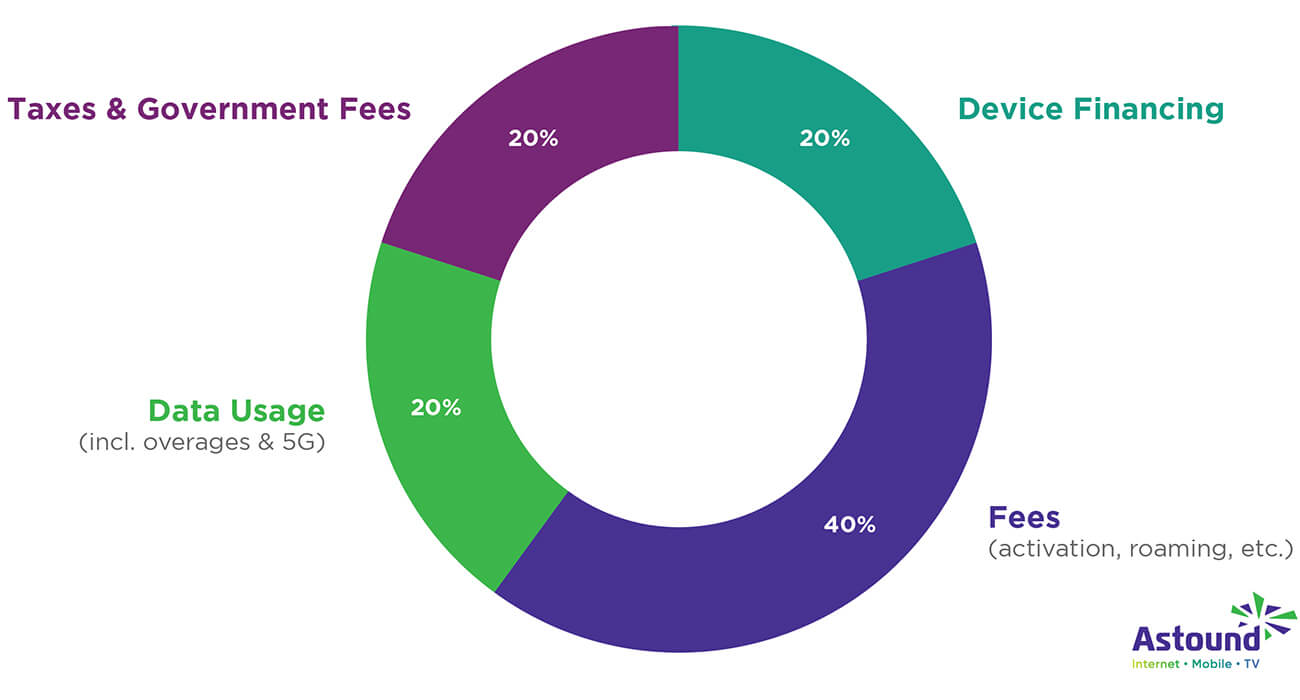
(Pie chart segment stats include taxes & government fees: 20%; device financing: 20%; fees such as activation and roaming: 40%; and data usage including overages and 5G access: 20%.)
The chart shows how much each type of charge impacts your monthly cell phone bill and why staying informed about each one can help you make better decisions when selecting a phone plan.
Switching is easy
Switch & Save
Getting started with Astound is easy: just bring your phone or find a new one, pick a plan and add internet.
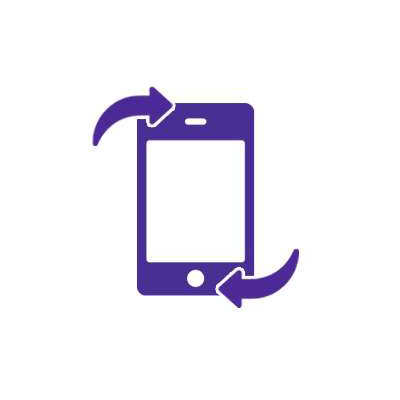
Understanding the monthly billing cycle
You might miss opportunities to manage costs or avoid unexpected charges if you don’t understand your billing cycle.
A monthly billing cycle is a recurring period during which your carrier tracks and charges for mobile services. It typically begins on the day your service is activated and ends on the same day of the following month, such as the 22nd or 23rd. Most carriers bill one month in advance, charging you for the next month’s service during the current cycle.
Your cell phone’s monthly bill includes the following charges:
- Data charges: Based on your data plan type (limited or unlimited plans).
- Number of lines: The more lines in your account, the higher the monthly bill.
- Device payments: Your monthly phone installments if you are financing a new phone.
- Taxes and government fees: These fees include federal and state taxes, which vary by state and locality.
- Insurance or protection plans: Charges that cover phone loss, theft or damage.
Understanding each item in your bill helps spot overcharges or unnecessary services.
Many carriers now offer billing management tools within their mobile apps. These features enable you to track data usage in real-time, view your next bill, receive alerts when you approach your data limits and adjust plans or features mid-cycle. They offer control, helping you manage your monthly phone bills effectively.
6 reasons your cell phone bill is high
If you are frustrated by a higher-than-average cell phone bill, here are six reasons why your bill might be high in 2025.
Unlimited data plans
While unlimited data plans sound great on paper, many users do not need them. The average user consumes up to 21 GB of data per month yet pays an average of $70 to $100 for unlimited plans that they don’t fully utilize.
Additionally, if your plan includes 5G access or premium add-ons, your monthly charges rise without providing extra value.
Increasing the number of lines
Adding more lines to your household can significantly increase your monthly costs. For example, a family plan charging $50 per line for a family of four can cost up to $200 per month, excluding device financing or extra features.
To save costs, evaluate each member’s data needs and opt for a mix and match plan.
Type of phone
Upgrading to a newer phone could mean signing a financing contract, which adds an extra $20 to $40 to your phone bill throughout the contractual period. If multiple lines include device payments, the costs become long-term expenses that outlast the excitement of upgrading.
Phone insurance
While phone insurance offers peace of mind, it costs $10 to $15 monthly. With deductibles, claim limits and caps on device replacement values, the extra costs may outweigh the benefits, especially if you rarely lose or damage your phone.
Taxes and fees
Many users may overlook the taxes and local fees included in their cell phone bills. However, these charges may range from 10% to 20% of your bill.
Additional fees
In addition to your base plan costs, you may incur additional charges, such as early termination, roaming, account activation, or data overage fees.
Let’s examine Jane’s expenses to understand why phone bills may increase. She pays:
- $80 a month for an unlimited 5G plan.
- $30 to finance her phone.
- $12 for insurance.
- $20 in roaming charges due to frequent travel.
- $10 in taxes and surcharges.
- $10 in streaming services as add-ons.
Her monthly cell phone bill comes to $162, which is significantly above average. The higher cost is due to the accumulation of plan features, device payments, taxes and extras that inflate a phone bill over time.

5 tips to lower your cell phone
If you are tired of overspending on your cell phone bill in 2025, try these practical tips to slash your bill without compromising on services.
1. Use WiFi when possible
Connect to WiFi whenever possible to reduce your data usage, especially at home, work or public places that offer free WiFi. Using WiFi regularly helps you stay under your data cap and avoid overage fees.
2. Monitor background data
Most apps run in the background and consume data when you’re not using them. Check your phone settings to turn off background data to conserve bandwidth and prevent unexpected overages from app activities running in the background.
3. Switch to a low-cost carrier
Consider switching to low-cost carriers called Mobile Virtual Network Operators (MVNOs). These carriers, such as Astound Mobile, offer cheaper phone plans ranging from $15 to $40 per month, saving you up to $600 annually per line. If you want to keep your current line, you can switch to the MVNOs using an eSIM, which allows faster service activation and dual SIM flexibility.
4. Avoid phone payment plans
Financing a phone adds extra costs to your cell phone bill and locks you into long-term contracts with a carrier. Consider buying a phone outright or using a cheaper, refurbished phone to reduce monthly expenses.
5. Adjust your plan or bundle services
Evaluate your data usage habits and adjust your plan accordingly. If your monthly data usage is below 10GB, consider switching to a by-the-gig plan to avoid paying for data you don’t use. You can also save by bundling your mobile service with internet through carriers like Astound Mobile, unlocking discounts and simplifying your monthly billing.
Mobile + Internet + TV
Switch to Astound
Get Astound Mobile, Internet and TV—and save on the best services available.

Save more when you bundle home internet and mobile with Astound
While paying for mobile services and internet separately has been the norm, this could cost you more than necessary. Bundling services is a wise decision to reduce your monthly phone bills while keeping your services under one account.
Astound Mobile offers a bundled option that combines your home internet with mobile plans, providing convenience and savings. It runs on T-Mobile’s nationwide 5G network, offering fast and reliable coverage, while our fiber-powered infrastructure delivers consistent high-speed internet for your home.
To bundle services, Astound Mobile requires an Astound internet subscription. We offer options like 300 Mbps for $30 per month or Gig+ plans starting at $60 monthly. You can add up to five mobile lines and choose between the by-the-gig or unlimited data options.
Astound Mobile also offers special discounts, including a free unlimited mobile line for the first year (valued at $40 monthly). Additional unlimited lines cost $40 each and the 1.5 GB by-the-gig plans cost $10 monthly.
For example, if you sign up for a 300 Mbps internet plan at $30 per month and one unlimited mobile line (free for the first year), your total monthly cost is just $30. On average, you may spend between $70 and $110 monthly purchasing separate internet and mobile plans elsewhere.
Below is a savings comparison table comparing the cost of Astound’s bundled plans with separate internet and mobile plans.
Savings comparison per monthly cell phone bill
| Plan Type | Astound Mobile Cost (First Year) | Separate Internet + Mobile Cost | Monthly Savings |
|---|---|---|---|
| 300 Mbps Internet + 1 Unlimited Line | $30/month (free line for 1 year) | $70–$110/month (e.g., $30 internet + $40–$80 for mobile) | $40–$80/month |
| Gig+ Internet + 1 Unlimited Line | $60/month (free line for 1 year) | $100-$140/month (e.g., $60 internet + $40-$80 for mobile) | $40–$80/month |
| 300 Mbps Internet + 2 Lines (1 Unlimited, 1 1.5GB line) | $80/month ($30 internet + $40 unlimited after first year + $10 by-the-gig), ) | $110-$150/month. | $30-$70/month. |
|
Plan Type
300 Mbps Internet + 1 Unlimited Line |
Astound Mobile Cost (First Year)
$30/month (free line for 1 year) |
Separate Internet + Mobile Cost
$70–$110/month (e.g., $30 internet + $40–$80 for mobile) |
Monthly Savings
$40–$80/month |
|
Plan Type
Gig+ Internet + 1 Unlimited Line |
Astound Mobile Cost (First Year)
$60/month (free line for 1 year) |
Separate Internet + Mobile Cost
$100-$140/month (e.g., $60 internet + $40-$80 for mobile) |
Monthly Savings
$40–$80/month |
|
Plan Type
300 Mbps Internet + 2 Lines (1 Unlimited, 1 1.5GB line) |
Astound Mobile Cost (First Year)
$80/month ($30 internet + $40 unlimited after first year + $10 by-the-gig),
)
|
Separate Internet + Mobile Cost
$110-$150/month. |
Monthly Savings
$30-$70/month. |
Build your plan
Your perfect plan is just a click away
Get the speeds, WiFi, mobile and TV plans you need all at an affordable price. Bundle your services with Astound and see how much you can save.

Conclusion
Are you still overpaying on your cell phone bill in 2025? While the average phone bill for a single-line phone ranges between $70 and $100 and family plans cost between $160 and $200, the wrong phone plan could leave you wasting money on services you don’t need.
Without proper setup, your monthly phone bill can rise significantly due to factors such as unused data plans, multiple lines, device financing and hidden taxes and fees.
Implement practical tips such as considering mix and match family plans for multiple lines, bundling internet and mobile services or switching to low-cost carriers like Astound Mobile. These changes can result in cost savings without sacrificing coverage or features you need.
Frequently Asked Questions
Do phones have monthly bills?
Yes, phones come with monthly bills that include charges for the data plan, device payments, talk and texts, add-ons like streaming services or insurance and surcharges. These charges vary depending on your carrier plan type and data usage.
Are phone bills expensive?
Yes, phone bill costs are rising each year. In 2025, the average phone bill ranges between $150 and $160. This increase is due to 5G adoption, inflation, increasing data demand and monthly device payments.
How much does a phone cost per month?
The monthly cost of a phone depends on the financing agreement with your carrier. It typically ranges between $20 and $40 per month, depending on the total device price and the contract length, usually 24 or 36 months.
How much is a phone bill for one person?
For individual users, unlimited data plans typically cost between $70 and $100 per month, while by-the-gig plans, such as 5 GB or 10 GB, are more affordable, ranging from $25 to $40 per month.
How much is a cell phone bill for a family?
A family phone bill typically ranges between $160 and $200 per month, depending on the number of lines. However, mix and match plans can greatly reduce the costs. For example, combining two unlimited data lines at $70 each and two 5 GB by-the-gig lines at $25 each totals $190 monthly. Paying for four separate unlimited plans could cost up to $280, saving up to $90 per month.
Why is my cell phone bill so high?
Your cell phone bill may be high due to various factors like:
- Unused unlimited plans
- Device financing
- 5G surcharges
- Add-ons like streaming services
- Phone insurance
- Taxes and government surcharges
These costs add to your base plan and raise your monthly bills.
What are mobile charges?
Mobile charges are the services that make up your monthly phone bill. They include:
- Your data plan price
- Device financing payments
- Carrier fees including activation, roaming or early termination fees
- Taxes and government fees
- Data overages
- Insurance
Be aware of each charge to help you better manage your phone bill.
How does your billing cycle work?
Your billing cycle is a monthly period, for example, from April 23rd to May 22nd, during which your mobile services, such as data plans, device installment payments or data overages, are tracked and billed. Most carriers bill one month in advance and charge you for the next month’s service during the current cycle.
How can I get a cheap cell phone bill?
To lower your cell phone bill:
- Switch to low-cost carriers for cheaper phone plans.
- Connect to WiFi whenever you can to minimize mobile data usage.
- Disable background data for unused apps.
- Skip device financing by purchasing a phone outright or opting for refurbished phones.
- Switch to by-the-gig plans if you use less than 10 GB per month.
- Bundle internet and mobile services for discounts and cost savings.
How much can I save with a bundled internet and mobile plan?
Astound Mobile can save you up to $40 to $80 monthly. For example, if you bundle 300 Mbps internet with one unlimited line (free for the first year), you’ll only pay $30 monthly. In contrast, paying for a separate internet plan at $30 and a mobile plan for $40 costs you $70.
How much will I pay per month with Astound Mobile?
Your monthly costs depend on the internet speed, the number of mobile lines in your plan and available discounts. With Astound Mobile, a 300 Mbps plan with one unlimited line costs just $30 during the first year. After the first year, the unlimited line costs $40, bringing the total cost to $70. Adding a second line, such as the 1.5 GB plan at $15, brings your monthly bill to around $85.
Get Mobile + Internet Together
Find the mobile service, home internet and streaming that’s just right for you.
Astound Mobile requires Astound Internet service. Coverage not available in all areas. A trademark of Ziff Davis, LLC. Used under license. Reprinted with permission. Where available. © 2024 Ziff Davis, LLC. All Rights Reserved. All names, logos, images and service marks are property of their respective owners. ©2025 Radiate Hold Co., LLC d/b/a Astound Broadband. All rights reserved.
This website contains instructional information, including from third-party sources, and is intended, but cannot be guaranteed, to be always up-to-date, complete and accurate. Astound does not endorse, and is not responsible for, any third-party content that may be accessed through this website. Any representation or warranty by Astound that might be otherwise implied by information on this website is expressly disclaimed. Astound expressly disclaims all liability or responsibility with respect to actions taken or not taken based on any or all of the instructional information contained on this website. Astound does not warrant or guarantee the availability of any services at any specific time or geographic location or that services will be provided without interruption. Not all aspects of the Astound services function on all equipment and devices. Use of this website is subject to the Web Site Disclaimer and Web Content Accessibility Policy.


